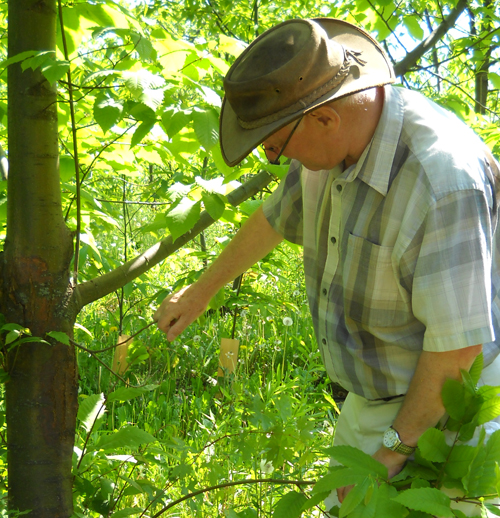
Could this be the one? Amid the plantation of young American chestnut trees growing on a former farm field in southern Ontario, one sapling has caught the eye of U of G plant agriculture professor Adam Dale. He stops to look more closely at the smooth bark of the trunk and the long, tooth-edged leaves that have sprouted by late May.
Look at how much more healthy this one appears than its neighbours, he says. Sure enough, the striplings on either side show thinner foliage and even bare, dead-looking branches – not to mention telltale cracking and reddish blotches spreading like a rash over their trunks.
Those two neighbours are doomed, says Dale. But this one in the middle just might hold the key to restoring the American sweet chestnut to the forests of eastern North America.
Castanea dentata once accounted for about one in four of the trees in this part of the world, providing timber and nuts for food. “The American chestnut was probably one of the dominant tree species in the Carolinian forest all the way from southern Ontario to Georgia,” says Dale.
Then came chestnut blight, imported accidentally from China. By the mid-1900s, the fungus had annihilated most of the native chestnut species; the tree was listed as threatened by 1950.
Only 1,000 to 2,000 trees are left in Canada. Today the largest single group of American chestnut trees in the country grows on a few acres in southern Ontario planted and tended within the past decade under a recovery project led by the Canadian Chestnut Council.
As with a companion project in the United States led by the American Chestnut Foundation, the goal is to develop blight-resistant trees that may be reintroduced to the North American countryside and streetscape.
“We’re crossing resistant trees with native trees to get trees that are resistant that we can put back into our forests,” says Dale.
Key to the project is tree breeding done from U of G’s Simcoe Research Station by Dale and research technician Dragan Galic. Since 2002, they have crossed and re-crossed chestnut specimens in a hunt for the elusive few that harbour natural resistance to the blight.
Progress has been slow but steady, says Dale.
He hopes to begin distributing resistant trees in about six years for planting on farms and conservation areas, although he says it’s unlikely that he will see much of a recovery in his lifetime. “It takes hundreds of years. I think it’s worth doing, it’s a challenge and we have to look after the plant.”
Grown at the Simcoe station, the new seedlings are brought in the spring to this test plantation in St. George, Ont., between Brantford and Cambridge.
This year’s crop comes from nuts collected last fall from trees showing signs of resistance after having been deliberately infected with the fungus.
By the end of planting day in late May, about 15 volunteers will have set out 1,000 seedlings in two freshly plowed furrows stretching up a hillside. That will expand the plantation, already a four-acre parcel carved from a corner of the 400-acre Tim Hortons Onondaga Farms (THOF). The project includes another two acres of chestnuts growing on a farm near London.
As with the earliest existing trees planted in 2006, these newcomers will be inoculated with the fungus in turn. Nuts from only the least infected ones will be chosen for another round in this real-life version of Survivor. “The last trees standing will be the most resistant,” says Dale.
Returning to the grove during July flowering time, the researchers will collect pollen from the trees’ catkins to fertilize promising candidates. The researchers cover the flowers with bags to prevent wind and insect pollination.
Survivors will likely be planted near the few naturally surviving trees in southern Ontario to improve the chances of propagation.
Now 64, Dale began breeding berry crops decades ago. He’s also part of a group hoping to develop a homegrown hazelnut industry.
He was asked to help by the Canadian Chestnut Council, formed in 1988.
That group’s outreach co-ordinator is Kelly Schafer, who runs environmental programs for children and other guests at the THOF.
“It was our initial mistake that caused the introduction of the blight. We have chosen to make a difference,” says Schafer, who regularly discusses the project with groups on and off the farm.
Adds Jeff Hoffman, senior manager, community relations, for the Tim Horton Children’s Foundation and a U of G political science grad: “The chestnut plantation is a great teaching tool for young people who come here. We want to bring back an important species. It’s important to care about the environment and show kids how to find their own way to care about their community.”
Galic hopes to find trees that can fend off the blight entirely or perhaps learn to survive with the fungus as a chronic condition. “I’m quite convinced we’re on the right path.
“We’re trying to bring back something that is on the verge of disappearing,” he says. Pointing out that the American chestnut was once a dominant Carolinian species, he adds, “It’s in our national fabric. It’s going to be part of our landscaping. It also has huge potential for the forestry industry.”
The project costs about $30,000 a year. Funding has come from the Ontario Trillium Foundation, governments, and numerous public and private donors. A new $96,000 grant this year will allow the group to study ways to grow and propagate the trees.